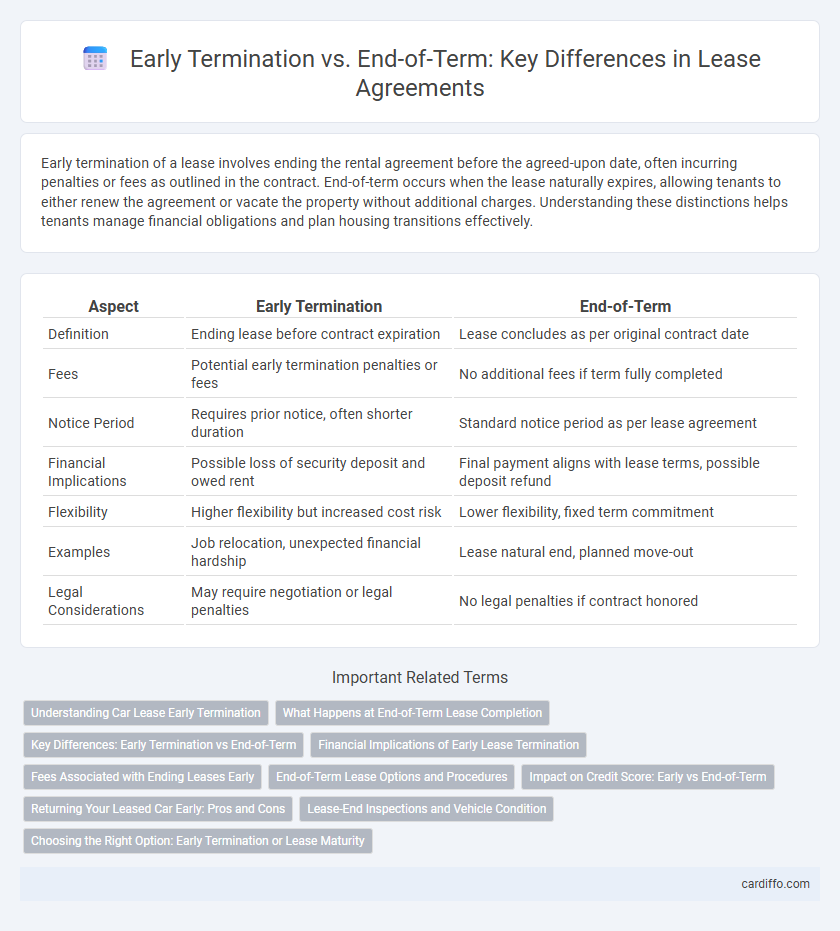Early termination of a lease involves ending the rental agreement before the agreed-upon date, often incurring penalties or fees as outlined in the contract. End-of-term occurs when the lease naturally expires, allowing tenants to either renew the agreement or vacate the property without additional charges. Understanding these distinctions helps tenants manage financial obligations and plan housing transitions effectively.
Table of Comparison
| Aspect | Early Termination | End-of-Term |
|---|---|---|
| Definition | Ending lease before contract expiration | Lease concludes as per original contract date |
| Fees | Potential early termination penalties or fees | No additional fees if term fully completed |
| Notice Period | Requires prior notice, often shorter duration | Standard notice period as per lease agreement |
| Financial Implications | Possible loss of security deposit and owed rent | Final payment aligns with lease terms, possible deposit refund |
| Flexibility | Higher flexibility but increased cost risk | Lower flexibility, fixed term commitment |
| Examples | Job relocation, unexpected financial hardship | Lease natural end, planned move-out |
| Legal Considerations | May require negotiation or legal penalties | No legal penalties if contract honored |
Understanding Car Lease Early Termination
Understanding car lease early termination is crucial for avoiding unexpected fees and penalties that often arise when ending a lease before its scheduled end-of-term date. Early termination may involve paying the remaining lease balance, early termination fees, and potential depreciation costs, which can significantly increase the overall expense compared to simply returning the vehicle at lease end. Reviewing lease agreements and consulting with leasing companies can help identify options such as lease transfers or buyouts to mitigate financial impact.
What Happens at End-of-Term Lease Completion
At end-of-term lease completion, lessees typically return the leased asset in agreed condition, avoiding excess wear and mileage charges. The lease agreement concludes without penalties, allowing lessees to purchase the asset, renew the lease, or walk away. Early termination often incurs significant fees, contrasting with the predictable obligations and options available at natural lease end.
Key Differences: Early Termination vs End-of-Term
Early termination of a lease occurs when a tenant or landlord ends the lease agreement before the contractually agreed expiration date, often involving penalties or fees, whereas end-of-term signifies the natural conclusion of the lease period without such penalties. Early termination typically requires negotiation, potential compensation, and may impact credit scores, while end-of-term allows for lease renewal negotiations or smooth vacating procedures. Understanding the distinctions between early termination and end-of-term is critical for managing obligations, avoiding legal issues, and planning tenant transitions.
Financial Implications of Early Lease Termination
Early lease termination often incurs significant financial penalties, including forfeiture of security deposits and payment of remaining rent obligations or lease break fees. Tenants may also be responsible for costs related to re-leasing the property, such as advertising and brokerage fees, which increase overall expenses compared to holding the lease until end-of-term. Understanding these financial implications is critical for tenants considering early exit strategies versus maintaining the lease until its natural conclusion.
Fees Associated with Ending Leases Early
Ending a lease early typically incurs early termination fees, which can range from one to three months' rent or a predetermined penalty outlined in the lease agreement. In contrast, leases completed at the end-of-term usually avoid these additional charges but may require fees for property repairs or cleaning. Understanding the specific terms related to early termination fees helps tenants anticipate the financial impact of ending a lease prematurely.
End-of-Term Lease Options and Procedures
End-of-term lease options typically include renewal, purchase, or returning the leased asset, with procedures varying by contract specifics and jurisdiction. Lessees must notify lessors in writing within the specified window--often 30 to 90 days before lease expiration--detailing their decision to renew, buy, or vacate. Property or equipment condition assessments usually precede lease closure, ensuring compliance with agreed terms and avoiding penalties.
Impact on Credit Score: Early vs End-of-Term
Early termination of a lease can negatively impact your credit score as it often involves missed or late payments and potential fees reported to credit bureaus. End-of-term lease completion typically has no adverse effect on credit if all payments are made on time and the vehicle is returned as agreed, demonstrating financial responsibility. Proper lease management and timely communication with the leasing company are crucial to maintaining a healthy credit profile during lease periods.
Returning Your Leased Car Early: Pros and Cons
Returning your leased car early can save on extended monthly payments but may incur early termination fees outlined in the lease agreement. End-of-term lease returns typically avoid these penalties and provide options to buy the vehicle or lease a new one. Evaluating mileage limits, wear and tear policies, and financial implications is crucial for making an informed decision.
Lease-End Inspections and Vehicle Condition
Lease-end inspections assess the vehicle's condition to identify any excess wear or damage, directly impacting potential charges at the end of the lease term. Early termination often triggers a similar inspection but may include additional fees or penalties for remaining lease obligations and increased depreciation. Understanding the specific criteria for acceptable vehicle condition in the lease agreement helps minimize unexpected costs during both end-of-term and early lease termination inspections.
Choosing the Right Option: Early Termination or Lease Maturity
Evaluating early termination versus lease maturity involves assessing financial penalties, remaining lease obligations, and long-term cost implications. Early termination may offer flexibility but typically incurs fees and forfeits deposits, while lease maturity allows for a seamless transition without additional charges. Prioritizing contract terms and future needs ensures selecting the option that minimizes losses and aligns with business or personal goals.
Early Termination vs End-of-Term Infographic

 cardiffo.com
cardiffo.com